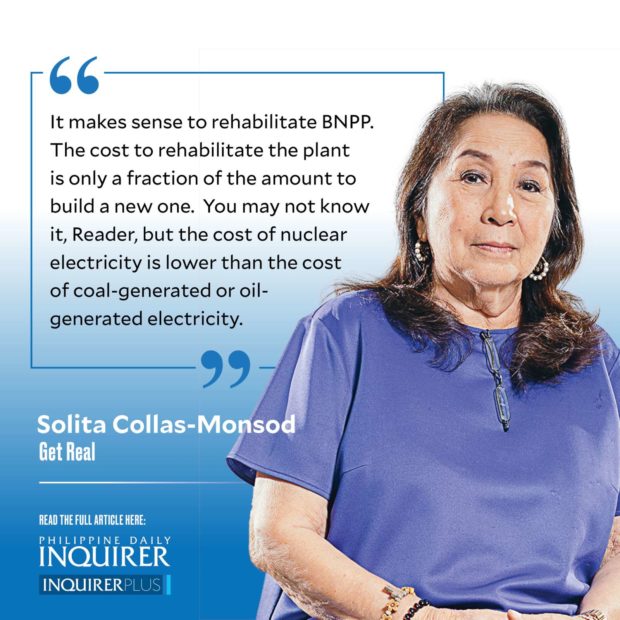Think about it, Reader. If today, the government completed a project costing about P1.5 trillion (7.7 percent of the country’s GDP), and then proceeded to relegate it to the dustbin, i.e., decided not to use it, meanwhile adding about 10 percent to the country’s foreign debt, what would you think?
That’s not all. If as a result the country would be plunged into an energy crisis with 12-hour rolling brownouts for about a four-year period, while faithfully paying the debt over 20 years, what would you say?
You would think the government incompetent, or just plain stupid, yes? Yet that’s exactly what the government did in 1986 with regard to the Bataan Nuclear Power Plant (BNPP). And its action had widespread approval (the move was encouraged by a very loud segment of the populace) because the BNPP exemplified Marcosian corruption, and the world had just witnessed a disaster in the Chernobyl nuclear power plant in the Soviet Union.
That Chernobyl was not comparable to Western-built power plants (watch Mark Cojuangco’s nuclear power containment demonstration on YouTube)—because the latter have containment, while the former does not—was not considered at the time. And that Marcos’ corruption was already a sunk cost was not considered either. Emotion drove the BNPP decision, not cool heads.
But apparently, there has been a change in the mood of the Filipino people. According to one of the whereas clauses in President Duterte’s Executive Order No. 164, a public perception survey on nuclear energy in 2019 indicated that 79 percent of Filipinos expressed approval or acceptability of the possible use or rehabilitation of an existing nuclear power plant, and about 65 percent approved the building of new nuclear power plants. It seems that we Filipinos do look at the data and the evidence before we make decisions. I hope that is true for our elections as well.
Cojuangco points out that there is a precedent to the BNPP’s being taken out of mothballs, and I checked it out. The Watts Bar II nuclear power plant in Tennessee, US, apparently started construction before the BNPP, but construction was stopped in 1985 (due to perceived lack of demand) when the project was 80 percent complete. Twenty-two years later, construction recommenced, and in October 2016, Watts Bar II was completed. It is the first US nuclear reactor to enter commercial operations since 1996.
So it makes sense to rehabilitate BNPP. The cost to rehabilitate the plant is only a fraction of the amount to build a new one. You may not know it, Reader, but the cost of nuclear electricity is lower than the cost of coal-generated or oil-generated electricity. Plus, the carbon emissions of nuclear electricity are lower even than solar-generated electricity. And the British medical journal The Lancet finds that nuclear power is the safest way to make reliable electricity. The TED Talk by Michael Shellenberger on YouTube will convince you. It is entitled “Why I changed my mind about nuclear power”—because he was an antinuclear activist.
Nuclear energy is alive and strong in many parts of the world, contrary to what you have been led to believe, and the use of advanced small modular reactors (vs. the giant 600-1,000-megawatt plants) currently under development are being promoted by the US Department of Energy. They are talking about packages which can produce from 10 to 300 megawatts, less expensive than the ones the world has now.
And BTW, did you know that the US has 96 operating reactors, and that the state of Illinois, with one-half of the Philippines’ land area, and little over 10 percent of our population, has 11 nuclear power plants? I mention this because Illinois is where antinuke scientist Kelvin Rodolfo has taught and researched and lived all these years. And Kelvin doesn’t think we should have even one. Just getting your dander up, Kelvin.
France, which has less than twice our land area and about 67 million people, has 58 reactors. The price people pay for electricity in France is reportedly one-half of what Germans pay—Germany depends more on coal and oil, and closed or suspended their nuclear plants after the Japanese disaster.
I could go on and on, with South Korea, India, Japan, Taiwan. China is apparently set to build 150 reactors in the next 15 years.
What are we waiting for?
——————
solita_monsod@yahoo.com
